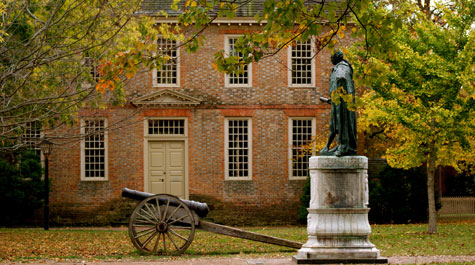William & Mary embarks on extensive renewal of its second-oldest building
The College of William & Mary today announces an effort to renew and preserve the historic Brafferton. The project, which will require $4.5 million to complete, will be financed through privately raised funds.
For nearly three centuries, the Brafferton — the second oldest building on William & Mary’s Historic Campus — has stood alongside the Sir Christopher Wren Building and the President’s House. Together, the three buildings form the most intact surviving colonial campus in the United States.
“The Wren Building and the President’s House have both undergone renewals of their own in recent years,” said William & Mary President Taylor Reveley. “The Brafferton represents an early and significant contribution to Virginia’s architectural history, and it has played a varied and important part in the College’s life since 1723. The Brafferton has not received any significant remedial attention since the early 1930s and now desperately needs help. The proverbial wolf is at the door. We must act to ensure that the Brafferton’s integrity is preserved.”
The Brafferton was built with funds from the estate of Robert Boyle, a famous English scientist, and was designed to house the College’s Indian School. At the time of the American Revolution, the College lost the income from the Boyle estate, and the Indian School was discontinued. Since then, the Brafferton has served a variety of purposes, including dining hall, faculty residence, dormitory and classroom building. The Brafferton now hosts offices for the College’s president and provost.
“The brick walls of the Brafferton are some of the oldest and finest masonry in Williamsburg,” said Louise Kale, executive director of the Historic Campus.
The renewal project will address the preservation needs of the Brafferton, the safety of its occupants and the replacement of building systems that have exceeded their life expectancy.
With an extraordinary grant of $1 million from The Lettie Pate Evans Foundation, the College is able to begin working on the project ahead of schedule. Lettie Pate Whitehead Evans, the first female Coca-Cola board member, established the Foundation in 1945. Foundation grants are limited to specific public charities in Georgia and Virginia.
The College’s fundraising efforts received another fortuitous boost when the Mary Morton Parsons Foundation simultaneously issued a challenge to the College to raise an additional $900,000 for the Brafferton project by Dec. 31, 2011. If the College raises that amount, the foundation will provide a $300,000 grant. The Parsons Foundation, which provides financial support for capital projects for tax-exempt organizations in Virginia, also provided generous grant funding for the Wren Building renewal project that was completed in 2000.
In response to the Parsons Foundation's challenge, William & Mary’s Class of 1961 helped build momentum for the project by making the effort to renew and preserve the Brafferton its 50th Reunion Class Gift project. To date, the class, which recently celebrated its reunion, has raised more than $550,000. With the support of Lettie Pate Evans Foundation, the Parsons Foundation and the Class of 1961, the College has secured more than $1.85 million.
Construction on the Brafferton and archaeology of the site is expected to last about a year. When the renewal project is completed, passersby shouldn’t notice changes in the building’s historic appearance, Kale said.
“The most fundamental goal is for the hand of the architect to be invisible,” she said. “It’s about the health of the building, not the appearance of the building.”
Engaged learning at William & Mary happens inside and outside the classroom, and the Brafferton renewal is no exception. Students from William & Mary’s Anthropology Department participating in an archaeological field school will be involved in the extensive excavation required at the site. The field school, which will begin this summer thanks in part to the funding provided by the Lettie Pate Evans Foundation grant, is a research collaborative between the College and the Colonial Williamsburg Foundation.
In addition, the Brafferton Legacy Group, comprising four Native individuals who are also William & Mary alumni, has been formed to represent communities with links to the College’s 18th-century history. In conjunction with the College’s American Indian Resource Center, the Brafferton Legacy Group hosted a pre-excavation ceremony. Native leaders and tribal representatives from the Mid-Atlantic region attended the April 30 event.
For more information about the project, visit the project's web site.
 Skip to main content
Skip to main content

